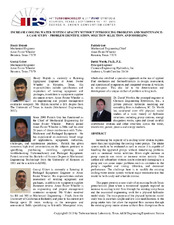| dc.contributor.other | International Pump Users Symposium (31st : 2015) | |
| dc.creator | Ushev, Georgi | |
| dc.creator | Huynh, Henry | |
| dc.creator | Guy, Patrick | |
| dc.creator | Werth, David | |
| dc.date.accessioned | 2017-09-09T21:58:45Z | |
| dc.date.available | 2017-09-09T21:58:45Z | |
| dc.date.issued | 2015 | |
| dc.identifier.uri | https://hdl.handle.net/1969.1/162190 | |
| dc.description | Lecture | en |
| dc.description.abstract | Increasing the capacity of a cooling water system requires more than just upgrading the cooling water pumps. The intake system needs to be evaluated as well to ensure it is capable of handling the upgraded pumps without introducing problems such as increased vortex activities. Even slight increase in pump capacity can create or increase vortex activity. Free surface and subsurface vortices can be extremely damaging to a pump and can cause major problems such as cavitation to the pump’s impeller and casing, vibration, and decreased performance. The challenge here is to modify the existing cooling water intake system without major reconstruction that would be both costly and schedule intense. This paper presents a case study of an existing South Texas petrochemical plant where a turnaround upgrade required an increase in cooling water flow through the existing sump basin and the associated engineering work for a physical hydraulic model study. The main purpose of the physical hydraulic model study was to ascertain simple and low cost modifications to the pump intake bays that allow the required flow increase through the existing pump intake system without flow disruptions from the higher flow volume. The hydraulic model replicated the fundamental flow parameters in the sump’s pump intake bays and led to an inexpensive, timely, and easy to implement solution that did not require major construction changes to the intake system. With physical modeling, the intricate interaction between cooling water and air can be analyzed and tested, a task that computational fluid dynamics cannot achieve to the required degree of precision. The physical model identified increased air entraining vortex activity and was used to develop remedial vortex suppression pipe modules that are in the process of being designed, constructed, and mounted on each pump intake bay. A follow up paper will cover the modification, implementation, and commissioning as a continuation of this paper. | en |
| dc.format.medium | Electronic | en |
| dc.format.mimetype | application/pdf | |
| dc.language.iso | en | |
| dc.publisher | Turbomachinery Laboratories, Texas A&M Engineering Experiment Station | |
| dc.relation.ispartof | Proceedings of the 31st International Pump Users Symposium | en |
| dc.subject.lcsh | Pumping machinery | en |
| dc.title | Increase Cooling Water System Capacity Without Introducing Problems And Maintenance | en |
| dc.type.genre | Presentation | en |
| dc.type.material | Text | en |
| dc.format.digitalOrigin | born digital | en |
| dc.identifier.doi | https://doi.org/10.21423/R1CK76 | |


